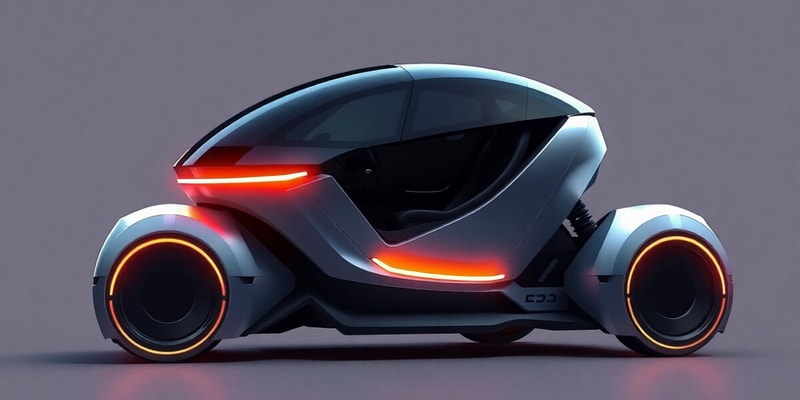Podcast
Questions and Answers
What major function does the drivetrain serve in the model?
What major function does the drivetrain serve in the model?
Which of the following parts is NOT indicated in the motor shaft assembly?
Which of the following parts is NOT indicated in the motor shaft assembly?
In the modeling operations mentioned, which sequence is least effective for creating complex part features?
In the modeling operations mentioned, which sequence is least effective for creating complex part features?
What is the primary goal of 'Design-by-Features' in engineering geometry?
What is the primary goal of 'Design-by-Features' in engineering geometry?
Signup and view all the answers
Which of the following components is responsible for transmitting power from the motor to the wheels?
Which of the following components is responsible for transmitting power from the motor to the wheels?
Signup and view all the answers
In terms of engineering design, how are features typically added after defining the shape?
In terms of engineering design, how are features typically added after defining the shape?
Signup and view all the answers
Which of the following is a learning objective stated for the engineering design course?
Which of the following is a learning objective stated for the engineering design course?
Signup and view all the answers
What is one of the basic feature types students will learn about in CAD systems?
What is one of the basic feature types students will learn about in CAD systems?
Signup and view all the answers
What is the focus of the course in the Engineering Design + Computing Laboratory?
What is the focus of the course in the Engineering Design + Computing Laboratory?
Signup and view all the answers
Which alteration in CAD modeling steps could produce the object displayed in the bottom view?
Which alteration in CAD modeling steps could produce the object displayed in the bottom view?
Signup and view all the answers
What impact does changing the parameters of a modeling step have on the final object?
What impact does changing the parameters of a modeling step have on the final object?
Signup and view all the answers
If the 'hole' step is executed before the 'shell' step, what is likely the result?
If the 'hole' step is executed before the 'shell' step, what is likely the result?
Signup and view all the answers
What process can help in visualizing the effect of each modeling step in CAD?
What process can help in visualizing the effect of each modeling step in CAD?
Signup and view all the answers
What is the primary reason for using a 'pattern' step in CAD modeling?
What is the primary reason for using a 'pattern' step in CAD modeling?
Signup and view all the answers
When would it be most beneficial to replace a modeling step in CAD?
When would it be most beneficial to replace a modeling step in CAD?
Signup and view all the answers
What could be a consequence of applying features in the incorrect order?
What could be a consequence of applying features in the incorrect order?
Signup and view all the answers
Why is it important to understand the interaction of modeling steps in CAD?
Why is it important to understand the interaction of modeling steps in CAD?
Signup and view all the answers
What is a characteristic of profile tolerance in assembly features?
What is a characteristic of profile tolerance in assembly features?
Signup and view all the answers
What does a co-axial assembly feature involve?
What does a co-axial assembly feature involve?
Signup and view all the answers
Which shape is used to describe the termination of an extrusion as shown in the feature verification process?
Which shape is used to describe the termination of an extrusion as shown in the feature verification process?
Signup and view all the answers
Which statement best describes overlapping fillet and round features?
Which statement best describes overlapping fillet and round features?
Signup and view all the answers
What is meant by 'model history' in design verification?
What is meant by 'model history' in design verification?
Signup and view all the answers
What role does a sketch play in the extrusion model history?
What role does a sketch play in the extrusion model history?
Signup and view all the answers
What is the purpose of edge blending in model history?
What is the purpose of edge blending in model history?
Signup and view all the answers
What does the term 'termination' refer to in feature verification?
What does the term 'termination' refer to in feature verification?
Signup and view all the answers
What is the first step in creating a parametric model?
What is the first step in creating a parametric model?
Signup and view all the answers
Which action is performed to modify an existing parametric model?
Which action is performed to modify an existing parametric model?
Signup and view all the answers
What would happen if the relation p0 = 90mm is replaced with p0 = p1 + 10mm?
What would happen if the relation p0 = 90mm is replaced with p0 = p1 + 10mm?
Signup and view all the answers
What does a parametric relation typically define in a model?
What does a parametric relation typically define in a model?
Signup and view all the answers
Which of the following is NOT a typical operation when handling constraints in parametric modeling?
Which of the following is NOT a typical operation when handling constraints in parametric modeling?
Signup and view all the answers
What is indicated by the relation R = b/2 in parametric modeling?
What is indicated by the relation R = b/2 in parametric modeling?
Signup and view all the answers
What is the purpose of geometric constraints in a parametric model?
What is the purpose of geometric constraints in a parametric model?
Signup and view all the answers
Study Notes
Learning Objectives
- Students will learn to think about design parametrically in CAD systems.
- Students will understand the concept of a feature, basic feature types and their properties.
- Students will understand what part families are and how they are used.
- Students will be introduced to Additive Manufacturing (3D Printing).
CAD Model of the PLUS II
- PLUS II is an electric vehicle
- Made of several components including chassis, bodywork, windshield, electronics, door, steering system, front wheels, drivetrain, back wheels
- Example of CAD model used to design these components
Drivetrain
- Example component of PLUS II
- Composed of electric motor, wheel, suspension
Example part from Kyburz: Motor Shaft
- Motor shaft is an example of design using CAD features
- The motor shaft is broken into various parts with different function and material properties
- Parts are indicated by different colours eg, orange - bearings, green-sealings, blue-drive shaft, pink-coupling motor, red-differential drive, grey-gears, transmission
- Drivetrain is a key component of electric vehicles.
Question: Modeling operations
- The question asks about the best way to represent the basic shape of a part in CAD, using geometric modelling operations
- The options are either 1. Extrusions only, or 2. Revolves only
How can we encode the engineering meaning of geometry?
- CAD features can be used to encode engineering meaning of geometry
- This is referred to as "Design-by-Features"
- This makes designing easier to understand, manage and modify
- Example of this is in the design of a gear
- A gear is a complex shape, with many features such as key seat, chamfer, centre hole, locking pattern, groove
- Features are built up on top of basic geometry to create complex shapes
- Example of features: chamfer, round, mirror geometry
Assembly and Tolerance Features
- Assembly features allow parts to be assembled and constrained in CAD software
- Example of assembly feature - co-axial assembly features, where parts are aligned and attached to each other
- Tolerance features are used to control dimensional accuracy of parts
- Tolerance features ensure that a part is within specified limits
- Example - profile tolerance feature
Feature Verification
- Feature verification is important to ensure CAD features work as intended
- Features can sometimes interact with each other, creating unexpected geometry
- Example - fillet and round feature, where the round overwrites the fillet
- Model History can show how a model was created
- History can show a breakdown of the features used to create the model
History Dependency and Interaction
- CAD models have 'history' meaning they remember how they were created
- History can be used to modify a model easily
- Changes to a model can have cascading effects on other features
- Example: modifying a hole feature can affect a pattern or shell
Question: Alternative Model
- This question asks about modifying a sequence of modelling steps in CAD
- Modifying the sequence of steps can change the outcome of a design
- Example - switching the order of 'shell' and 'hole' operations can create a different result
Sketch and Parametric Modeling Overview
- Parametric modeling allows for flexible and dynamic design
- Parametric modelling uses constraints and parameters to define geometry
- The relationships and constraints define how geometry should behave
- The model automatically updates when parameters change
- Example: changing the length of a line can affect the position of other geometric entities
Question: Parametric Modeling
- This question asks about how a parametric model responds to changing its parameters
- Changing parameters can change the model because of defined relationships
- The constraint solver will find the new solution and update the model accordingly
How to Create a Parametric Model
- Parametric models are created by linking geometric entities using parameters and constraints.
- Constraints define relationships between different geometric entities in a CAD model.
- Example constraints include:
- Lines parallel to lines
- Lines perpendicular to lines
- Circles tangential to lines or other circles
- Points constrained to a specific location.
- Parameters are used to define specific values for the constraints.
- Example parameters include:
- Angles
- Lengths
- Radii.
Studying That Suits You
Use AI to generate personalized quizzes and flashcards to suit your learning preferences.
Related Documents
Description
This quiz explores design parametrics in CAD systems and key features related to the PLUS II electric vehicle model. Students will learn about part families, additive manufacturing, and the specific components involved in the vehicle's drivetrain. Test your understanding of CAD concepts and their application in designing modern electric vehicles.




